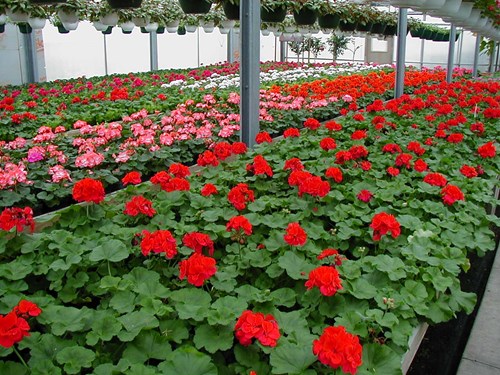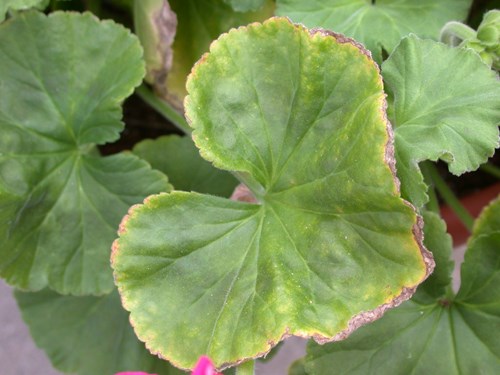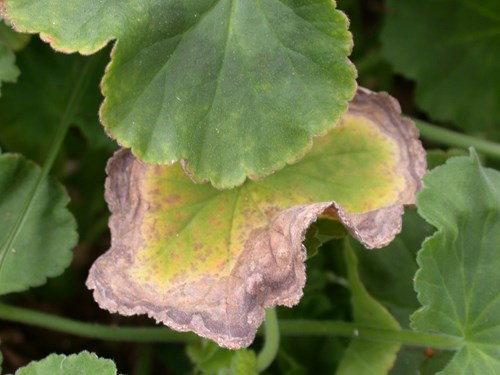Cause of pH Drop in Geranium


When the issue of nutrient uptake by greenhouse crops is considered, plants can be broken down into three groups. The groups are based on the optimum media pH for nutrient uptake and include: (a) iron-inefficient or the Petunia group, (b) the general group and (c) the iron-efficient or Geranium group. The focus of this article is on one of the plants from the iron-efficient group, geraniums.
Plants and micronutrients in greenhouses
In their native environment, iron-efficient plants grow in soils with few micronutrients, so they had to adapt in order to obtain what few micronutrients were available. The iron-efficient plant group is able to easily take-up iron and manganese; however this can be a problem in the greenhouse growing environment where many other crops have difficulty obtaining iron and manganese from the growing medium.
Today’s fertilizers are designed to accommodate the micronutrient needs for a wide range of plants, so micronutrient levels may be high for geraniums. However, this depends greatly on the pH of the growing medium. Iron and manganese are more soluble at lower pH levels, making them more available to the plant. Toxic levels are easily reached in the tissue of iron-efficient plants if the pH of the growing medium falls below 5.8; therefore, the ideal pH for these plants is 6.0-6.6.

Ammonium based fertilizer
It is generally understood that when fertilized with an ammonium based fertilizer, plant roots exchange acid ions for the ammonium ions, which causes a general decrease in growing media pH. This is also true of urea, which microorganisms in the growing medium convert into ammonium. Geraniums also release acid ions when taking up ammonium, but they are unique in that they will also release acid into the growing medium if they are deficient in phosphorus. Most water soluble fertilizers used in the greenhouse tend to be fairly low in phosphorus, compared to nitrogen and potassium.
During warm bright days, geraniums can consume the available phosphorus in the growing medium, which initiates the release of additional acid in the growing medium. This additional acid causes the growing medium pH to decrease, making any soil-bound phosphorus soluble and, therefore, more available. The downside of this chemical reaction is the decrease in the growing medium pH increases the availability of iron and manganese, which can lead to iron-manganese toxicity.
Hyper-release
This process of acid release caused by low phosphorus is called hyper-release and can happen very quickly and result in a pH drop of as much as 2.0 units. Symptoms of iron-manganese toxicity show up on the oldest leaves as brown speckling on the leaf edges. Eventually the whole leaf edge turns brown and progresses inward towards the leaf petiole. Damage to geranium foliage from iron and manganese toxicity will not correct itself once the pH of the media has been corrected. Damaged leaves will need to be removed and new foliage must be grown.


Fertilizers
It is not recommended that geraniums be fed with a high rate of blended fertilizers because they often have high rates of micro-nutrients, which can be at toxic levels. Use fertilizer with a higher percentage of nitrate nitrogen (>70%) in comparison to ammonium plus urea (<30%). Also try to avoid using very low phosphorus fertilizers as they exacerbate iron-manganese toxicity in geraniums.
To avoid iron-manganese toxicity, a grower should monitor growing media pH on a regular basis. Action must be taken quickly if the media pH starts to drop below 5.8. These steps include changing to a more basic fertilizer and in extreme cases, applying additional limestone, either as a liquid drench, or a top dress.
Monitor water alkalinity
As with all crops, growers should monitor their water alkalinity, fertilizer levels and growing media pH on a regular basis. Geraniums can be beautiful and profitable for growers if iron-manganese toxicity can be avoided.